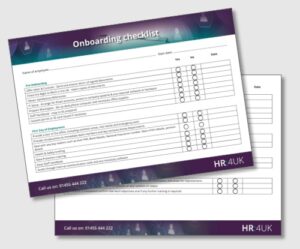Employee Onboarding: What To Do – and What Not To Do

33% of employees quit in their first 90 days. Why? Poor employee onboarding1.
What is employee onboarding?
Put simply, onboarding is the process of bringing newly hired employees into an organisation and integrating them into the current set-up as painlessly as possible.
Starting a new job can be a stressful experience for many, and, as an employer, the best way to maximise your new colleague’s potential is to ensure that their needs are met from the get-go.
Note that onboarding differs from, but also encompasses, orientation: the latter is the initial process of introducing a new employee into the workplace, familiarising them with the environment and company policies as well as informing them of their expected job roles and helping them get to know their new colleagues.
The former, meanwhile, is the ongoing way in which an employee is successfully integrated into the existing company culture. Orientation is a necessary task and should be done within days or weeks, but a great employee onboarding process can take weeks, months – even a year or more.
Download our free onboarding checklist

What to do during onboarding (and not to do)
DO: Understand the importance of onboarding
With over a quarter of employees resigning within their first three months of employment, and staff turnover a costly and reputation-damaging experience for many businesses, the process of onboarding shouldn’t be underestimated.
Polling organisation Gallup found that while only 12% of employees felt that their company did a fantastic job with their onboarding, those employees were almost three times as likely to say that they had the best possible job2.
Meanwhile, only 29% of new hires felt as though they were supported and integrated enough into their new role to perform effectively.
Conversely, those employees who are thoroughly in harmony with the business thanks to their employee onboarding process consistently show and encourage:
- Increased profitability
- Improved staff turnover rate
- Healthier relationships with colleagues
- A better cultural fit
- An enhanced safety record and compliance with regulations
- Reduced absenteeism and presenteeism
- Higher end-product
- Greater commitment, belief and self-confidence
The first few days and weeks of employment are a crucial time for new employees. In it, they make judgments about company culture, their colleagues and their decision to join. Good onboarding can mean that their experiences affirm their choices, help them integrate into the business and reduce their overall ‘time to competency’ – the process whereby an employee attains the necessary skills and information to contribute positively to the team.
The role of current staff
It is integral to the process that all staff know and are aware of their role in bringing in new staff. ‘Onboarding is everyone’s responsibility’ is a common phrase in many organisations, and while true, it lacks efficacy if those responsibilities are not well understood. Consider the following guidelines when implementing an effective strategy in your organisation:
The HR Department
Responsible for completing and organising employee paperwork, work hours, timetable and conducting facility tours.
The Training Department
Tasked with delivering onboarding program components, facilitating discussions and lectures on organisational culture, goals, and objectives and reviewing company videos.
Supervisor
Holds the responsibility of discussing job duties, responsibilities, work behaviours and performance expectations. They typically introduce the new employee to team members and other personnel within the organisation, and may provide a department tour as well as explain various roles and relationships within the department.
Co-workers
Sharing information on how the team collaborates, accomplishes tasks, locates tools and equipment and seeks support within the organisation are all absolutely crucial in ensuring the successful onboarding of new recruits.
Executive team
Assists in helping the new employee understand the organisation’s mission, vision, values, strategic goals and objectives. They provide an overview of higher-level roles and responsibilities and describe the prevailing organisational culture.
Assigned to guide the new employee by introducing them to team members and other individuals in the organisation, explaining informal rules and policies, and being available to answer day-to-day questions.
DON’T: Ignore the benefits of good structure
Although different companies have differing approaches to employee onboarding, some key characteristics remain across the board. These include:
Preboarding
This typically involves:
- Inviting the employee (and possibly their family) to tour the premises and local area.
- Mailing/emailing information to the employee regarding the business.
- Matching the new employee to a buddy or mentor that can help guide them.
Orientation
A structured occasion designed to acquaint incoming employees with the organisation’s framework, vision, mission and values, orientation usually involves going through the employee handbook, necessary paperwork and undertaking compulsory training. To prevent overwhelming the new employee with information overload, it is recommended to conduct this process over the span of a few days or, ideally, a week.
Foundation Building
This is the process whereby company values and identity are ingrained and fostered. To do this effectively, the business will need to communicate its distinctive cultural pillars, mission, brand and message. New hires will not absorb all of this information in the first few weeks or even months; indeed, Gallup’s Creating an Exceptional Onboarding Journey for Your New Employees suggests that this can and should take up the better part of a year.
Mentoring
Many businesses offer a mentoring or buddy system, either formally appointed by HR or informally discussed within the company. This role is designed to make the new hire feel at ease both in their role and in their environment: it can range from mundane tasks such as pointing out the location of the cafeteria or toilets to helping an employee get to grips with the real essence of their new job.
Reboarding
Employees often need extended time off, be it for a holiday, a layoff or a medical/maternity leave period. For this reason, it’s essential to reacclimatise your erstwhile colleague with all of the changes that have been made over the course of their absence in order to get them back up to speed.
Examples might include any new staff that have arrived, colleagues switching roles or even new policies that have been introduced in the ensuing period.
DO: Tailor Your Experience
Every new employee is unique, and brings alongside them a set of distinct challenges and benefits. Whether it’s down to the seniority level of the position or their individual circumstances, businesses should always be sensitive to the specific needs and requirements that new starters require.
Executives and Managers
Upper levels of management will often require the most thorough onboarding of all, as they require extensive knowledge and understanding of the company’s ethos, its role in the market and the steps it takes in order to function efficiently – even if the new staff is brought in specifically to change aspects of the business.
Workers of Diverse Backgrounds
Disabled, neurodivergent, BAME or LGBTQ+ individuals may need additional information and may have specific requirements to allow for their set of circumstances and both employees and managers should be made aware of this from the outset in order to secure successful integration.
Veterans/Formerly Incarcerated Workers
Returning to the world of everyday work when returning from military service or incarceration can be a daunting task. Such workers may need greater time to acclimate to their new surroundings that others, and certain special dispensations may be useful, such as the aforementioned buddy/mentoring system.
Contract Workers
Those hired to consult or contract with your business may nevertheless need a sufficient degree of information in order to proceed in step with the company’s intentions: billing methods, the nature of the premises, the company branding and a wide array of other topics all need to be addressed to ensure that you get the best out of your arrangement.
DON’T: Overburden – or neglect – your employees
There are three big mistakes that employers often make during or before the onboarding process, according to experts HR Dive3.
1. The Silent Treatment
Once a candidate has received their offer letter, one of the cardinal sins of onboarding is to leave them asking questions about the specifics of the role. You can avoid this mistake by keeping in continual (but not overbearing) contact with the new hire and providing a guide to the business, their role and what they can hope to expect.
2. The Not-So Warm Welcome
If you’re in a bigger business with lots of new employees on a regular basis, you might be forgiven for seeing yet another new one as a minor event. However, it’s important to note that for the individual in question, their entry into your business can be a life changing one. As such, it’s recommended to have something of a minor celebration to welcome them in so that they feel appreciated and valued from the offset.
3. The Information Overload
Sometimes a delicate balance has to be maintained between keeping your new protégé informed but not overwhelmed. Simply dumping all of the available forms, procedures and policies on an individual’s lap is likely to cause them distress and may even hint at burnout in the near future. Instead, place measured, drip-fed pieces of information in their lap so that they have the time and energy to assess, process and memorise what is required.
DO: Measure your success
An effective onboarding process can yield (almost) instant results. This can occur in many forms, but some key markers that you’re on the right track – or otherwise – are as follows:
Time-to-productivity
In essence, the time it takes for your new colleague to get up and running. Establish performance indicators and measure them against the time took to reach them and you have a case for how effective your onboarding process is.
Staff turnover and retention
Another excellent way to determine the value of your process is to examine what your turnover and retention rates are in any given year, and then make adjustments accordingly. Generally those who quit early have been misinformed or the job has failed to meet their expectations; an effective employee onboarding can eliminate these concerns.
Employee satisfaction
Whether it be in the form of a survey, informal feedback, discussions with colleagues or management or just an excellent level of productivity from the beginning, assessing an employee’s level of satisfaction and wellbeing (or lack thereof) is a superb indicator into how effective your onboarding process has been.
With these tips we hope that your business manages to get the best out of any and all newcomers. For further information, or if you have any questions or queries, please contact our dedicated team of professional advisers today on 01455 444 222 or email: [email protected].
References:
1. Jobvite. (2018) Job Seeker Nation Study. https://web.jobvite.com/rs/328-BQS-080/images/2023-01-2018JobSeekerNationSurvey.pdf
2. Gallup (2020). Gallup’s Perspective on Creating an Exceptional Onboarding Journey for New Employees. https://www.gallup.com/workplace/247076/onboarding-new-employees-perspective-paper.aspx
3. Taylor, T. (March 14th 2017). How to avoid common onboarding mistakes. https://www.hrdive.com/news/how-to-avoid-common-onboarding-mistakes/438071/
James Dawson
James is our resident wordsmith and has many years of experience in writing about a huge variety of topics from HR to Occupational Health and beyond. He has been published in numerous magazines and news outlets, and especially enjoys researching and analysing the current trends in the modern business world.




